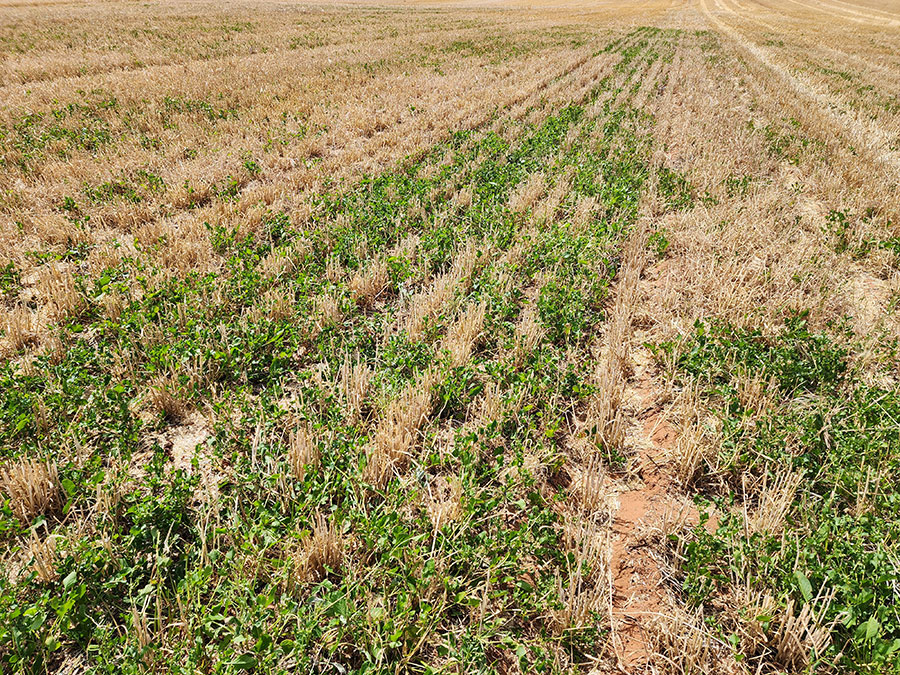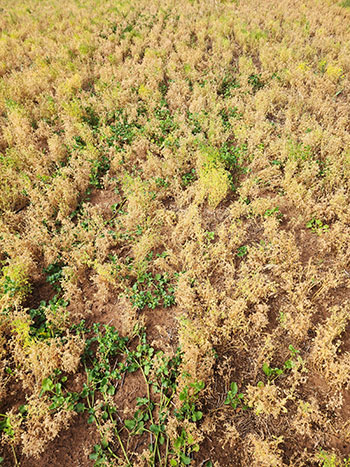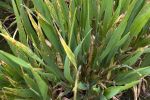Spiny emex weed species are an emerging challenge in South Australia that is proving especially difficult to control during the lentil phase of a crop rotation
Controlling spiny emex species in lentils has emerged as a significant constraint on sandy-textured soils in the western areas of the mid and upper north and the Yorke Peninsula regions of South Australia.
At the South Australian Research and Development Institute (SARDI), researchers are studying the production cycle of spiny emex species, mapping their geographic range and estimating the economic and farming impacts.
Led by Dr Navneet Aggarwal, the GRDC investment is also assessing current control tactics, including past successes and ongoing challenges for management.
Three-corner jack (Rumex hypogaeus, synonym Emex australis) and lesser jack (Rumex spinosus, synonym Emex spinosa) belong to the family Polygonaceae found in SA cropping.
E. australis is native to southern Africa, while E. spinosa is native to the Mediterranean region and Asia Minor. They are collectively referred to as ‘spiny emex’ species and are difficult to manage due to their rapid vegetative and reproductive growth.
They can adversely affect harvest efficiency and grain quality through contamination.

Spiny emex plants that survived in lentils and wheat. Photo: Navneet Aggarwal
Impacts
Wheat yield losses of 37 per cent have been recorded at a weed density of four spiny emex plants per square metre compared with weed-free controls in previous studies.
Growers have reported that while spiny emex weeds can be controlled in cereals with herbicides, that is not the case for legumes and can make a crop like lentils basically undeliverable.
“Lesser jacks are also proving difficult to clean out of harvested cereal and lentil grains,” Dr Aggarwal says.
Contaminated grains have incurred price penalties of $15 to $20 a tonne due to emex seeds, even after grain cleaning has been done at a cost of $40 to $50/t. The additional freight for extra trips to silos due to grain rejection can amount to $30/t.
The financial loss due to grain cleaning alone is estimated to be close to $2.6 million a year, based on an estimated 20,950 hectares affected by emex.
Growers are increasingly concerned about excessive weed seed build-up. Additionally, sheep can get mouth and feet issues while grazing in paddocks infested with spiny emex species.
Management strategies
Multiple herbicide options are available for controlling spiny emex in cereals but not in the lentil phase of a crop rotation.
However, feedback from consultants, agronomists and growers in the project’s survey revealed instances when they could not achieve the desired level of weed control even in cereals.
Selective control of spiny emex species in lentils is challenging due to the limited herbicide options (Table 1) since both the crop and weed are dicotyledonous species.
Of the herbicides registered for broadleaf weed in lentils, four have efficacy against spiny emex species and the remainder have a suppression effect only, according to product labels.
The survey found almost every second consultant and grower was unable to control the weed in lentils with the available on-label herbicide options.
Table 1: Herbicides registered for lentils.
Broadleaf weed herbicides registered for lentils | Bladex® (5*), Broadstrike® (2), diuron (5), diflufenican (12), Intercept® (2), metribuzin (5), Reflex® (14), Terbyne® (5), trifluralin, Terrain® (14) |
|---|---|
Herbicides having efficacy on spiny emex species reported in product labels | Bladex®, Broadstrike® (suppression only), diuron, Intercept® (imidazolinone-tolerant lentils only), metribuzin, Terbyne® (suppression only), trifluralin (is not effective against spiny emex species at the registered rate of 1250ml/ha), Terrain® (suppression only) |
* Herbicide mode of action group
Source: Field Crop Herbicide Guide, Kondinin Group, 2021
Weed management experiments
Improved weed management strategies are being developed by including new herbicides, new herbicide usage patterns and new metribuzin-tolerant lentil varieties.
Feedback from local agronomists helped to identify viable experimental sites in the mid and upper north area around the Port Pirie, Wandearah, Warnertown, Mundoora and Port Broughton regions.
Field trials got underway in 2023 and 2024, run by SARDI in collaboration with Agricultural Consulting and Research led by Stefan Schmitt.
The experiments have investigated the lentil crop safety and efficacy of Groups 2, 4, 5 and 14 herbicides applied alone or in combinations for spiny emex species control. As this weed has staggered germination, multiple herbicide combinations might be necessary to achieve season-long control.
Paddock survey for resistance
A total of 20 paddocks affected by spiny emex species have been selected in the Port Pirie, Wandearah and Port Broughton regions.
 Spiny emex plants are an emerging weed control issue. Photo: Navneet Aggarwal
Spiny emex plants are an emerging weed control issue. Photo: Navneet Aggarwal
Growers and consultants were contacted to track the problematic patches, while Dr Peter Boutsalis and his team from Plant Science Consulting performed herbicide resistance screening studies on spiny emex species with pre and post-emergent herbicides from Groups 2, 3 and 5 in 2024 season.
Three populations of E. australis (three-corner jack) out of 15 and two populations of E. spinosa (lesser jack) out of four collected from survey paddocks were found resistant to Intercept® (post-emergent).
These two populations of lesser jacks were also found cross-resistant to Ally® (post-emergent), while all the other emex species were found susceptible to Ally®.
Emex populations were found susceptible to metribuzin (post-emergent), diuron (post-sowing pre-emergent) and trifluralin (incorporated by sowing).
Eighteen emex populations out of 19 were not controlled completely with Broadstrike® (post-emergent) in pot trials.
“The project has delivered findings to growers through a series of field days, annual group meetings and farming system group result booklets,” Dr Aggarwal says.
“In addition, based on the research findings in 2023 and 2024, opportunities to obtain new permits/registrations are being explored for effective control of spiny emex species in lentils with support from the GRDC.”
More information: Dr Navneet Aggarwal, navneet.aggarwal@sa.gov.au
Resources: Read more in GRDC’s Ecology of major emerging weeds.

























































